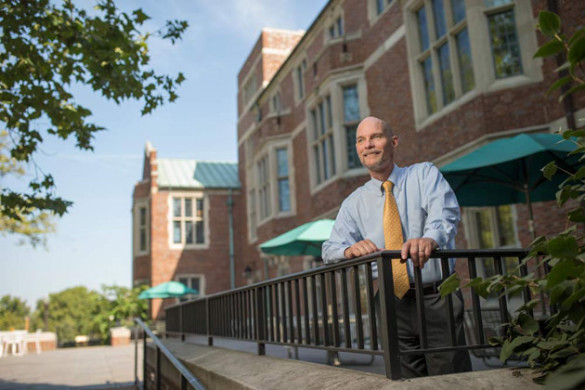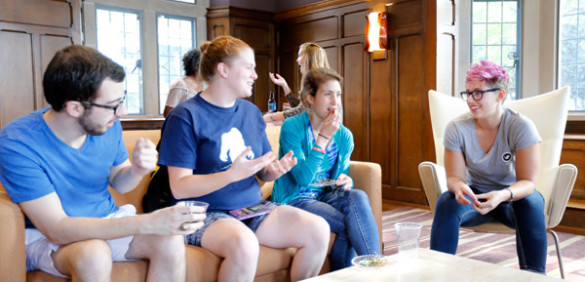
When Vanderbilt’s Graduate School relocated to Alumni Hall earlier this year, it was more than just a routine move from one office space to another. In a broader sense, it also represented a shift in philosophy—away from the more traditional notion of graduate education, where it is left largely up to departments working independently of each other, and toward a more holistic approach that better equips students for today’s fast-changing and heavily interconnected world.

“We’ve been doing graduate education the same way for far too long,” said Susan R. Wente, provost and vice chancellor for academic affairs. “There need to be changes to how we think about graduate education and how we prepare scholars for the current world.”
In contrast to the previous space on the fourth floor of Kirkland Hall, the new Alumni Hall location is not only more visible to the wider university community, but also more open and inviting. As a result, it better reflects the Graduate School’s mission to serve as the central hub for all Ph.D. and many master’s-level education programs offered by the university.
“This space is the centerpiece of what Vanderbilt’s vision for graduate education is, which is focused on building a greater sense of community,” said Mark Wallace, dean of the Graduate School, holder of the Louise B. McGavock Chair, and professor of hearing and speech sciences, psychology and psychiatry. “The move to Alumni Hall was intentional in the sense that we’ve created a true single point of contact on campus for the graduate community.”
This sense of community is something that Wallace himself found lacking when he earned both a master’s in biology and a Ph.D. in neurobiology from Temple University in the late 1980s. “I had a great educational experience, but there wasn’t really a sense of togetherness among the graduate students. That’s something I missed,” he recalled. But by virtue of his ongoing research in neuroscience, he has learned the value of collaborative work, particularly between disciplines.
“I’m a very interdisciplinary person, in part because I come from the field of neuroscience, which by definition brings people together from different areas to study the brain,” said Wallace, who is the former director of the Vanderbilt Brain Institute. “That kind of training is concordant with Vanderbilt’s Academic Strategic Plan and with what we want to do with graduate education, which is to create more trans-institutional endeavors and opportunities.”

One way Wallace is helping further this vision is through a new graduate readings program. Taking a page from The Commons Reading, in which all first-year undergraduate students read a designated book over the summer and then discuss it during the fall semester, he recently gave copies of the best-seller Thinking, Fast and Slow by Nobel Prize winner Daniel Kahneman to all incoming graduate students.
“We’re having programming throughout the fall to talk about this book. The overarching goal is to bring these students together to have multidisciplinary conversations,” said Wallace, who noted that the book itself tells an engaging interdisciplinary story, in that Kahneman applies his background in psychology toward better understanding how we make economic decisions.
The book also can be used as a springboard to talk about implicit biases—such as toward race, gender, sexual orientation and religion—that all people rely on in forming impressions and making decisions. In discussing these biases, Wallace hopes to draw the graduate community into the larger conversation happening on campus about diversity and inclusion. He says the Graduate School has made significant inroads in recruiting students from certain underrepresented communities, pointing to the success of programs like the Fisk–Vanderbilt Master’s-to-Ph.D. Bridge program, which is the nation’s top producer of minority Ph.D. recipients in physics, astronomy and materials science.
“Science, engineering and technology in the U.S. depend absolutely on the size and quality of the talent pool,” said Keivan Stassun, professor of astronomy and senior associate dean for graduate education and research, about the Bridge program he co-founded more than a decade ago. “Historically, we have not effectively drawn from what is now a third of our population.”

Wallace emphasized there is still much work to be done in creating a more welcoming environment for graduate students from all backgrounds. “For Vanderbilt to continue to be the great institution that it is, we have to embrace diversity in all forms,” he said. “We want to find individuals with a host of different perspectives on the world and put them together. That’s ultimately the best way to breed the next generation of thinkers and prepare them for the rapidly changing society we live in.”
Of all the changes facing graduate students these days, perhaps the most immediate one is the shifting job market. In recent years, the overall number of tenure-track positions nationwide has been shrinking, leaving many Ph.D.’s facing long odds of getting a job in academia. According to the National Science Foundation’s 2016 Science and Engineering Indicators report, in 2013 only 12 percent of those who had earned science, engineering or health doctorates within the previous three years had tenure or tenure-track faculty appointments.
But does this mean Vanderbilt’s Graduate School is producing too many Ph.D.’s? Wente doesn’t think so. “Societies would benefit from having more Ph.D.’s. They’re the future leaders not just of academia, but of industry, policy and every aspect of society,” she said. “We have to be positioning them to do that.”
Wallace agrees, noting that professional development is now a crucial component of Vanderbilt’s graduate education landscape. One group in particular that has done an exceptional job of this sort of training, he said, is the Biomedical Research, Education and Training office. “They do some fantastic things in the career development space and are an example to others on campus,” he said. “For instance, they have career symposia for their students where many trainees from Vanderbilt talk about how they’ve parlayed a Ph.D. in one discipline into a very different career path.”
That is not to say, though, that the Graduate School discourages Ph.D.’s from seeking faculty positions. Rather, Wallace likens the school’s aim to a balancing act of sorts. “I think there’s a real sweet spot where we need to value the academic path and train our students appropriately for that path,” he said, “but at the same time make sure we’re also giving them an opportunity in a much more expansive landscape.”
In the end, that is why Wallace and others at Vanderbilt are so keen to create a more tight-knit community of graduate scholars on campus. Being able to navigate that expansive landscape after graduate school, whether in academia, private industry or the public sector, requires an expansive education—one that is shaped by an understanding of diverse perspectives and a familiarity with the intersections between disciplines.
But for all the changes happening in graduate education at Vanderbilt and in the wider professional world beyond, Wallace acknowledges that one thing has remained constant. It is something all Vanderbilt graduate students can count on, regardless of their field. “If you have a graduate degree from Vanderbilt, it says something about you. It says you have a tremendous training pedigree and strong critical acumen,” he said. “And that carries a lot of weight, no matter where you are in life.”